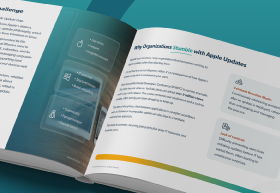While Apple’s latest updates are undoubtedly groundbreaking for end users, IT, and security professionals, they introduce a complex and critical layer of considerations.
It’s never “just about pushing an update button.” It’s about ensuring compatibility across your tech stack, diligently maintaining robust security postures, and meticulously preparing your entire fleet for what’s next.
Ignoring these operational ripple effects can lead to unforeseen disruptions, security gaps, and frustrated users.
Key Areas for IT Admins to Watch Out for:
- Effective Deployment
Start with a clear plan.
Methodically test every essential application with the new operating system versions. Adjust deferral policies to ensure sufficient time for testing and user preparation.
Once testing is complete, maximize efficiency by using deployment scripts and automation—integrated through your mobile device management (MDM) or unified endpoint management (UEM) solution, such as JumpCloud—for a streamlined rollout.
- Strategic Rollout
Use a phased deployment approach. Begin with a representative pilot group to identify potential issues, software conflicts, or usability challenges in a controlled environment.
Gradually expand implementation to the wider organization in measured stages. Assess your network infrastructure, and ensure it can support the increased demands of broad operating system updates.
- Device Management & Configuration
New Apple OS releases often bring new changes like mobile device management (MDM) keys and configuration options.
You’ll need to update existing configuration profiles and explore new ones to manage these changes effectively.
Ensuring your automated enrollment processes—like those facilitated through Apple Business Manager—remain seamless and fully functional is also critical for a smooth user onboarding experience.
- User Support & Training
Your help desk will inevitably face an influx of questions as users encounter new features, UI changes, or unexpected behavior. Proactive internal training for your support staff is essential to equip them with the knowledge to address these queries efficiently.
By establishing clear, accessible internal guides and comprehensive FAQs for newly introduced features, you can empower employees to self-serve, drastically reducing help desk tickets.
- Security Safeguards
Every new OS version requires a fresh evaluation of your security landscape.
A thorough review of the new privacy controls and understanding how updated authentication features (like Platform SSO) integrate with your existing identity provider is needed.
You should also verify that your current network filtering and data loss prevention (DLP) solutions remain fully compatible and effective.
With proactive analysis, IT can ensure that the new Apple features enhance, rather than compromise, your security posture.
JumpCloud: Ready for Apple’s Latest Updates
JumpCloud fully supports Apple’s latest operating systems: macOS 26 Tahoe and iOS/iPadOS 26. These releases introduce powerful user capabilities and significant enhancements for enterprise device management.
JumpCloud’s Patch Management and policy controls allow you to control the timing and scope of updates across your organization.
Our MDM solution is built for seamless compatibility with Apple’s modern management framework. JumpCloud software and agents are meticulously tested to ensure reliable performance in all supported Apple environments.
Explore More: Watch Our On-Demand Webinar
Ready to fully understand Apple’s latest enterprise features and how they impact your IT environment? Don’t miss our webinar: Apple’s macOS and iOS/iPadOS Updates: What IT and Security Teams Need to Know. Learn about the key changes, critical security implications, and how to seamlessly manage all new Apple features with JumpCloud.
Looking for an Apple MDM solution? Experience the benefits of JumpCloud’s unified platform firsthand. Sign up for a free trial or speak with a JumpCloud representative to discuss your MDM/UEM needs.




